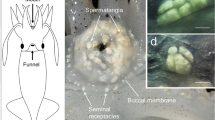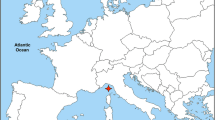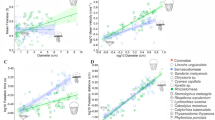Abstract
ECHINODERM larvae are capable of a variety of complex and apparently coordinated activities involving not only muscular movements but changes in the direction of ciliary beating1,2. The eight-armed pluteus larva of Strongylocentrotus droebachiensis (Cl. Echinoidea) normally swims with the arms leading, but when placed in sea water containing abundant particulate matter, such as unicellular algae, it shows occasional irregular periods of reverse locomotion. These are caused by reversal of the ciliary beat in the ciliated bands which run around the edges of the arms. At the same time, material may be ejected from the oral region, an activity assisted by contraction of the anterior dilator muscles. During a ciliary reversal the cilia of the epaulettes (isolated patches of ciliated epithelium) reverse or stop beating. The reversal response can be evoked by tactile or electrical stimulation of any part of the surface.
This is a preview of subscription content, access via your institution
Access options
Subscribe to this journal
Receive 51 print issues and online access
$199.00 per year
only $3.90 per issue
Buy this article
- Purchase on Springer Link
- Instant access to full article PDF
Prices may be subject to local taxes which are calculated during checkout
Similar content being viewed by others
References
Runnström, J., Bergens Museums Aarbok., n.r. 1, 59 (1918).
Strathmann, R., American Zoologist, 8, 804 (1968).
MacBride, E. W., Text Book of Embryology, 1, Invertebrata, 692 (1914).
Mortensen, T., Vid. Medd. Dansk, Naturh., 71, 133 (1920).
Sleigh, M. A., The Biology of Cilia and Flagella (Pergamon Press, London, 1962).
Kinosita, H., and Murakami, A., Physiol. Rev., 47, 53 (1967).
Carter, G. S., J. Exp. Biol., 4, 1 (1926).
Horridge, G. A., in The Cnidaria and Their Evolution, Symp. Zool. Soc., London, 16, 247 (Academic Press, London and New York, 1966).
Bone, Q., Nature, 181, 193 (1958).
Mackie, G. O., and Passano, L. M., J. Gen. Physiol., 52, 600 (1968).
Author information
Authors and Affiliations
Rights and permissions
About this article
Cite this article
MACKIE, G., SPENCER, A. & STRATHMANN, R. Electrical Activity associated with Ciliary Reversal in an Echinoderm Larva. Nature 223, 1384–1385 (1969). https://doi.org/10.1038/2231384a0
Received:
Issue Date:
DOI: https://doi.org/10.1038/2231384a0
This article is cited by
-
Scale-free vertical tracking microscopy
Nature Methods (2020)
-
Spatial and temporal patterns of gene expression during neurogenesis in the sea urchin Lytechinus variegatus
EvoDevo (2019)
-
Characterization of TRPA channels in the starfish Patiria pectinifera: involvement of thermally activated TRPA1 in thermotaxis in marine planktonic larvae
Scientific Reports (2017)
-
Vortex arrays and ciliary tangles underlie the feeding–swimming trade-off in starfish larvae
Nature Physics (2017)
-
Reply to 'Boundary effects on currents around ciliated larvae'
Nature Physics (2017)
Comments
By submitting a comment you agree to abide by our Terms and Community Guidelines. If you find something abusive or that does not comply with our terms or guidelines please flag it as inappropriate.



